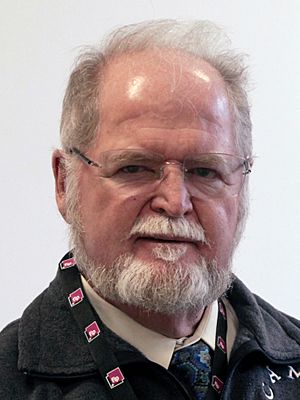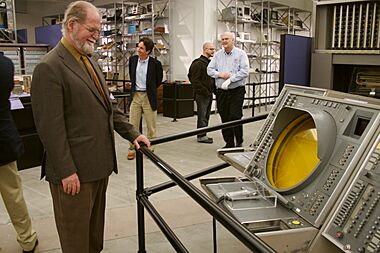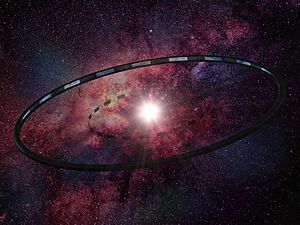Larry Niven facts for kids
Quick facts for kids
Larry Niven
|
|
|---|---|

Niven in 2010
|
|
| Born | Laurence van Cott Niven April 30, 1938 Los Angeles, California, U.S. |
| Occupation | Novelist |
| Alma mater | |
| Period | 1964–present |
| Genre |
|
| Notable works |
|
| Notable awards | Inkpot Award (1979) |
Larry Niven, born Laurence van Cott Niven on April 30, 1938, is a famous American science fiction writer. His 1970 novel Ringworld won many top awards. These include the Hugo and Nebula awards. He also wrote popular books like The Mote in God's Eye and Lucifer's Hammer with Jerry Pournelle. In 2015, he received the Damon Knight Memorial Grand Master Award for his amazing work in science fiction.
Niven is known for writing "hard science fiction." This means his stories use real science ideas and theoretical physics. His books often mix in elements of detective stories and exciting adventures. He also writes fantasy, like his The Magic Goes Away series. These stories explore a world where magic is a limited resource, like oil or gas.
Contents
Larry Niven's Early Life
Larry Niven was born in Los Angeles, California. He is the great-grandson of Edward L. Doheny. Doheny was an oil businessman who found oil in Los Angeles in 1892.
Niven went to the California Institute of Technology for a short time. He then earned a Bachelor of Arts degree in mathematics from Washburn University in 1962. He also studied mathematics at the University of California, Los Angeles. On September 6, 1969, he married Marilyn Wisowaty. She was a big fan of science fiction and historical romance novels.
Larry Niven's Creative Works
Larry Niven has written many science fiction short stories and novels. His first story, "The Coldest Place," came out in 1964. This story was about the dark side of the planet Mercury. At the time, people thought Mercury always showed the same side to the Sun.
Niven has won several major awards for his writing.
- In 1967, he won the Hugo Award for Best Short Story for "Neutron Star."
- He won the same award again in 1972 for "Inconstant Moon."
- In 1975, he won it for "The Hole Man."
- In 1976, he won the Hugo Award for Best Novelette for "The Borderland of Sol."
Niven often worked with other writers. He wrote nine novels with Jerry Pournelle. These include The Mote in God's Eye, Lucifer's Hammer, and Footfall. He has also collaborated with Steven Barnes, Brenda Cooper, and Edward M. Lerner.
Niven's Work in Television
Larry Niven has also written for science fiction television shows. He wrote scripts for the original Land of the Lost series. He also wrote for Star Trek: The Animated Series. For Star Trek, he adapted his own story called "The Soft Weapon." His story "Inconstant Moon" was also made into an episode for The Outer Limits.
Known Space Universe
Many of Niven's stories are set in his "Known Space" universe. In this universe, humans share space with many alien species. These include the fierce cat-like Kzinti and the very smart but shy Pierson's Puppeteers. These aliens often play important roles in his stories. The Ringworld series is part of the Known Space universe. Niven has even let other writers create stories in this setting.
Other Story Series
Niven also created The Magic Goes Away series. This fantasy series uses a special energy called mana to power magic. The The Draco Tavern series of short stories are lighter science fiction tales. They are told from the view of a bar owner who serves many different alien species.
His funny Svetz series includes short stories and a novel, Rainbow Mars. In these stories, a time machine is supposed to bring back extinct animals. Instead, it travels to different realities and brings back mythical creatures like a roc and a unicorn.
One of Niven's well-known humorous works is "Man of Steel, Woman of Kleenex". In this essay, he uses real-world physics to explore the challenges of Superman having a relationship with a human woman.
Larry Niven's Influence
Larry Niven's ideas have inspired other creative works. In the Magic: The Gathering card game, there is a card called Nevinyrral's Disk. This name is "Niven Larry" spelled backward. This tribute was made because the game's magic system was inspired by Niven's book The Magic Goes Away. Another card, Nevinyrral, Urborg Tyrant, was added later, bringing his namesake character fully into the game.
Niven's Laws
Larry Niven is also famous among science fiction fans for "Niven's Law." This law states: "There is no cause so right that one cannot find a fool following it." Over his career, Niven has added more "Niven's Laws." He describes these as "how the Universe works" based on what he has observed.
Images for kids
See also
 In Spanish: Larry Niven para niños
In Spanish: Larry Niven para niños




